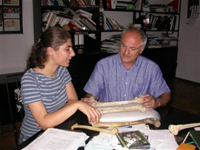
|
|
This undated handout photograph shows scientists David Lordkipanidze and Tea Jashashvili with remains of early human ancestors excavated at a site in the nation of Georgia. [Reuters]
|
The earliest-known human ancestors to migrate out of Africa possessed a surprising mix of human-like and primitive features, according to scientists who studied remains dug up at a fossil-rich site in the former Soviet republic of Georgia.
Writing on Wednesday in the journal Nature, the scientists described remains of three adults and one adolescent dating from about 1.77 million years ago, excavated at Dmanisi, about 55 miles southwest of the Georgian capital, Tbilisi.
The remains shed light on a little-understood but critical period in human evolution -- the transition from the more ape-like creatures known as australopithecines to the genus Homo, of which modern humans are a member.
The spines and lower limbs found at the Dmanisi site appear very much like modern humans, suggesting these individuals, which walked fully upright, were highly capable of long-distancetreks, the researchers said.
But other aspects of the skeletons had more archaic characteristics. The arms were more like australopithecines than people, and the primitive skulls encased relatively small brains. Their simple stone tools also are less advanced than one might have expected, the researchers said.
They described the remains as "a surprising mosaic" of primitive and modern features.
"These are the earliest humans found outside of Africa. This is the time when our genus spread outside of Africa," David Lordkipanidze of the Georgian National Museum, who led the research, said in a telephone interview. "Their heads are primitive. Their legs are very human-like."
Scientists had previously described skulls found at the site, but in recent years found far more extensive remains of the skeletons of these creatures, giving them a more detailed understanding of these denizens of early human history.
点击查看更多双语新闻
(Agencies)
|
科学家近日在前苏维埃社会主义共和国格鲁吉亚境内一处已被挖掘的化石遗迹考察时惊讶地发现,早期离开非洲大陆迁徙到其他地方的人类祖先兼具远古人类和猿类双重特点。
周三出版的《自然》杂志撰文说,科学家在格鲁吉亚首都第比利斯西南部约55英里一处名为德马尼西的地方发现了四具距今约177万年的化石, 其中包括三个成年人和一个青年人。
它们的出现将人们的目光聚焦到人类进化史中一段鲜为人知但十分重要的阶段,即从古猿又称更新纪灵长动物,进化到人类的过程,其中包括现代人类。
研究人员指出,该遗迹发现的早期人类脊骨和下肢化石与现代人类极其相似,说明这组化石完全具有人类直立行走特征,可以应付长距离跋涉。
但是它们的骨骼化石同时具有古猿特点,比如上肢更像更新纪灵长动物,且大脑较小。另外,他们使用的简单石器也比想象中要落后。
研究人员称该化石是兼具古猿类和现代人类双重特点“令人惊讶的综合体”。
“这是在非洲大陆以外发现的最早的人类化石,远古人类也在那时开始逐渐离开非洲,迁徙到世界各地”,此次研究的领导者,格鲁吉亚乔治亚国立博物馆的大卫洛基帕尼泽在电话采访中说到,“它们的头类似古猿,但是下肢却和人类相似。”
科学家以前曾对该地区发现的头骨化石进行过研究。近年来,越来越多的骨骼化石被发现,为他们进一步了解这些人类历史早期居民提供了更多详细的依据。
(英语点津于楠编辑)
|